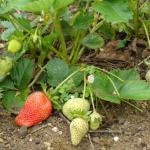Growing Strawberry Plants
Fragaria : Rosaceae / the rose family
| Jan | Feb | Mar | Apr | May | Jun | Jul | Aug | Sep | Oct | Nov | Dec |
|---|---|---|---|---|---|---|---|---|---|---|---|
| P | P |
(Best months for growing Strawberry Plants in USA - Zone 5a regions)
- P = Plant out (transplant) seedlings
- Easy to grow. Plant with crown (of roots) just covered.. Best planted at soil temperatures between 50°F and 68°F.
- Space plants: 12 - 39 inches apart
- Harvest in approximately 11 weeks. Strawberries bruise easily when ripe, handle carefully. Pick with a small piece of stem attached..
- Compatible with (can grow beside): Better in a bed on their own to allow good sun and air circulation
- Avoid growing close to: If you are using rotation beds, avoid putting strawberries where you have grown tomatoes, potatoes, peppers or eggplant
Strawberries are low-growing leafy plants which grow 12 - 15 cm (about 6 inches) tall and will spread to about 50 - 100 cm (20 - 40 inches). They have five petalled white or pink flowers. The flowers are followed by the delicious red fruits (which have their seeds on the outside).
Later in the season the plants send out runners like thin stems across the garden which will take root to form new plants. Cut them off and leave the parent growing. You can transplant the runners or let them grow where they rooted to produce new plants.
At the end of fruiting, trim off old yellow leaves and clean up any mouldy fruit still attached.
Strawberries like well drained soil with plenty of humus. To prepare your bed, dig in some compost before planting and possibly use a liquid fertiliser during the growing season. Well fed strawberries taste better.
To protect the fruit from moulds and mildew use some form of mulch around the plants. Straw, pine needles, or black plastic are all suitable. Mulch will also help suppress weeds.
Protect your plants with some sort of netting or bird scarer or you will lose most of your crop!
Strawberry plants often need replacing after a few years as they get affected by viruses and stop producing well.
Culinary hints - cooking and eating Strawberry Plants
Pick strawberries and eat them straight from the garden warm from the sunshine - delicious!
Strawberries can be used in any dessert needing soft fruit or berries. Summer pudding (which also has raspberries and blackberries or boysenberries), mousse, trifle, dipped in melted chocolate or just with cream.
Sprinkle a bowl of strawberries with balsamic vinegar and a little sugar to enhance the flavour and colour.
A quick jam of diced strawberries cooked in the microwave with an equal weight of sugar until completely soft won't keep but can be used right away.



Your comments and tips